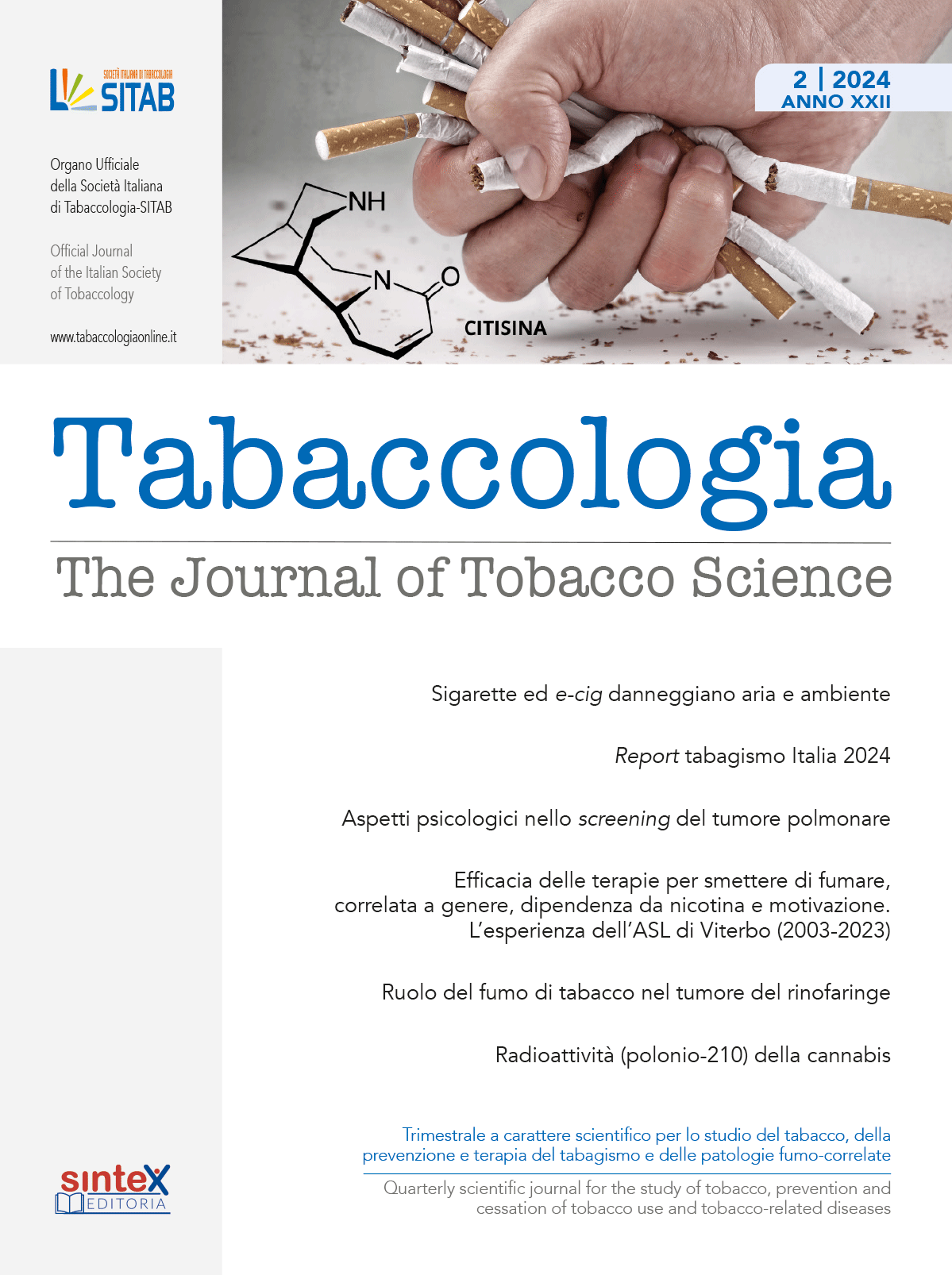|
Rassegna Stampa Scientifica Novembre 2023
|
“An additional 5 million Americans who smoke or used to smoke should undergo annual screenings for lung cancer — the number one cancer killer in the United States — according to an updated guideline issued Wednesday by the American Cancer Society. The broadened recommendations apply to about 19 million people who the cancer group said would benefit from yearly low-dose computed tomography scans… In the biggest change, the new guideline recommends that people continue to get annual scans even if they stopped smoking more than 15 years ago…. The mortality rate for lung cancer has declined sharply in recent decades because of plummeting smoking rates, but the health toll remains high. In 2023, the cancer society estimates, there will be about 238,000 new cases of lung cancer in the United States and more than 127,000 deaths, accounting for 20 percent of all cancer fatalities. Cigarette smoking is the main cause, responsible for about 80 percent of cases.” [Laurie McGinley. Millions more smokers should be screened for lung cancer, group says, Washington Post. Note: See below for full journal reference.]
“Quebec’s changes to its anti-tobacco law come into effect on Tuesday as the province aims to crack down on vaping. The province has officially banned the sale of flavoured vapes, with Health Minister Christian Dubé saying the revamped rules are designed to better protect young people… The crux of the changes comes down to prohibiting the sale of vape products in flavours other than tobacco as of Oct. 31. Vapes that have no flavour or aroma are still permitted, however. It’s also forbidden to sell any vapes in the “form of a toy, a piece of jewelry, a food, an animal or a real or fictional person, or any other form, appearance or function that might be attractive to minors.”… Aside from banning flavoured vapes, Quebec is also putting caps on size and refills. Stores can no longer sell vaping products with a nicotine concentration exceeding 20 milligrams per millilitre and vaping liquid tanks and capsules must be capped at 2 mm.” [Kalina Laframboise. Quebec’s ban on sale of flavoured vapes is now in effect. Here is what you need to know, Global News]
“The US Food and Drug Administration took a “momentous” step Monday [October 16] toward banning menthol in cigarettes and banning flavored cigars, proposing a rule that public health experts say could save hundreds of thousands of lives… The agency has sent the rule to the White House Office of Management and Budget for final review, the last regulatory step before the rule becomes final… Scientists have long understood that menthol flavor can make those cigarettes more addictive than tobacco-flavored ones. Menthol flavoring is attractive, particularly to new smokers, because it masks the harsh taste of tobacco, and a 2015 study found that it makes people want to smoke more.” [Jen Christensen. FDA takes ‘momentous’ step toward banning menthol cigarettes and flavored cigars, CNN]
“Big Tobacco firms including British American Tobacco (BATS.L) are selling heat sticks made from nicotine-infused substances such as rooibos tea, countering an incoming European Union ban on flavoured heated tobacco products. While the sticks mark a new way to inhale the addictive drug, health experts warn that their safety is unclear. The industry has produced "heat-not-burn" sticks containing tobacco for years, aiming to avoid the toxic chemicals released via combustion… Tobacco companies have yet to publish any research showing the health implications of rooibos or other zero-tobacco sticks.” [Emma Rumney. Big Tobacco turns to rooibos tea to counter upcoming ban, Reuters]
“The ACS [American Cancer Society] recommends annual LCS [lung cancer screening] with low-dose computed tomography for asymptomatic individuals aged 50–80 years who currently smoke or formerly smoked and have a ≥20 pack-year smoking history (strong recommendation, moderate quality of evidence). Before the decision is made to initiate LCS, individuals should engage in a shared decision-making discussion with a qualified health professional. For individuals who formerly smoked, the number of YSQ [years since quitting smoking] is not an eligibility criterion to begin or to stop screening. Individuals who currently smoke should receive counseling to quit and be connected to cessation resources.”
Screening for lung cancer: 2023 guideline update from the American Cancer SocietyCA: A Cancer Journal fo CliniciansFirst published: 01 November 2023Andrew M. D. Wolf, Kevin C. Oeffinger, Tina Ya-Chen Shih, Louise C. Walter, Timothy R. Church, Elizabeth T. H. Fontham, Elena B. Elkin, Ruth D. Etzioni, Carmen E. Guerra, Rebecca B. Perkins, Karli K. Kondo, Tyler B. Kratzer, Deana Manassaram-Baptiste, William L. Dahut, Robert A. Smith
Note: Open Access.
After adjustment for confounding, current ENDS [electronic nicotine delivery systems] use was associated with current traditional cigarette use (OR = 39.55; CI:33.44-46.77), current marijuana use (OR = 6.72; CI:5.61-8.05), history of lung cancer (OR = 2.64; CI:1.42-4.92), non-stroke cerebral vascular disease (OR = 1.55; CI:1.21-1.99), and chronic obstructive pulmonary disease (OR = 2.16; CI:1.77-2.63). Current ENDS use was also associated with increased risk of emergency room (ER) visits (HR = 1.17; CI: 1.05-1.30) and death (HR = 1.84; CI:1.02-3.32). Conclusions: Concurrent traditional cigarette use, marijuana use, and comorbidities were prevalent among those who used ENDS, and current ENDS use was associated with an increased risk of ER [emergency room] visits and death.”
Demographic, Clinical, and Behavioral Factors Associated With Electronic Nicotine Delivery Systems Use in a Large Cohort in the United StatesTob Use Insights. 2023 Jan 5:16:1179173X221134855. eCollection 2023.Shauna Goldberg Scott, Heather S Feigelson, John David Powers, Morgan N Clennin, Jason A Lyons, Mark T Gray, Anil Vachani, Andrea N Burnett-Hartman
Note: Open Access.
“Pack color modification may increase uncertainty about several key cigarette risk beliefs, though graphic warnings may attenuate these effects. Regulatory agencies could consider supporting policy changes with information campaigns to maximize public knowledge.”
Effects of cigarette package colors and warning labels on Marlboro smokers’ risk beliefs, product appraisals, and smoking behavior: a randomized trialBMC Public Health volume 23, Article number: 2111 (2023)Published: 27 October 2023Matthew D. Stone, Melissa Mercincavage, E. Paul Wileyto, Andy S.L. Tan, Janet Audrain-McGovern, Andrea C. Villanti & Andrew A. Strasser
Note: Open Access.
“Over 50 review studies, primarily in 2022 and 2023, illustrate some of the latest information on e-cigarette harms. Results show studies of respiratory, neurological, and cardiovascular effects. Researchers call for expanding studies through new methods to elaborate on initial findings of multiple harms emerging in clinical investigations. Since the use of electronic cigarettes for adult cessation is not sanctioned in most countries, it is clear that health authorities see significant costs to the health of the general population if the promotion and use of electronic cigarettes occur worldwide. Regulatory action to control electronic cigarettes should consider the substantial evidence of electronic cigarette harm.”
Electronic Cigarette Harms: Aggregate Evidence Shows Damage to Biological SystemsInt. J. Environ. Res. Public Health 2023, 20(19), 6808Published: 22 September 2023Stephen L. Hamann, Nipapun Kungskulniti, Naowarut Charoenca, Vijj Kasemsup, Suwanna Ruangkanchanasetr and Passara Jongkhajornpong
Also:
Air Pollution inside Vehicles: Making a Bad Situation Worse
Note: Open Access.
“Our current moment in tobacco control can be characterised as a struggle between two competing narratives: (a) tobacco use is a problem of unhealthy individual choices that can only be remedied by offering more choices, a recycled tobacco industry favourite; and (b) the endgame story—tobacco use is a problem of institutional failures to protect the public, highlighting increasingly absurd and unsustainable contradictions. We cannot continue forever to say that cigarettes kill but still sanction sales of the single most deadly consumer product in history as though it is normal to sell death. We cannot continue to claim we care about protecting public health while staying quiet as government agencies whose mission is to protect the public are grotesquely captured or hamstrung by industry influence…
“Regardless of how one feels about the potential of newer products to contribute to true ‘harm reduction’, we must make governments develop plans to end commercial cigarette sales. It will not happen all at once or overnight. There will be problems that must be thought through. But we cannot do it without talking about it and developing concrete plans—and we cannot, must not, continue to accept the status quo of this industrially produced and perpetuated epidemic.”
EditorialNew editor at the most exciting time in tobacco controlTobacco Control 2023;32:677-678.Online issue publication October 19, 2023Ruth E Malone
Note: Open Access. A new issue of the journal Tobacco Control (November 2023, V. 32:6) recently appeared online. Most reports were highlighted in earlier editions of this bulletin and are now Open Access. All others are available upon request. In the Editorial highlighted above, Ruth Malone also writes that “after many joyous, vexing, overloaded and exciting years of editing, I am ready to step down, leaving the top specialty journal in the field in capable hands with longtime Senior Editor and previous News Editor Dr Marita Hefler appointed as the journal’s new Editor-In-Chief.” I can only add my appreciation of Ruth’s extraordinary contribution over the years to both the journal and the field of Tobacco Control writ large. Very best wishes to Marita Hefler in her new duties as Editor-In-Chief.
“A decades-old public-health battle has flared up again, with leading Canadian anti-tobacco advocates from the Canadian Cancer Society, Canadian Lung Association and Physicians for a Smoke-Free Canada fiercely protesting the introduction of a new smoking cessation product. The cheerfully branded Zonnic (sounds like a relaxing “tonic” mixed with some “zing!”) has quietly settled like mist onto convenience store shelves, to be sold as an alternative to vapes and cigarettes. The product has sparked a firestorm of shock and cynicism aimed at British American Tobacco, the multinational corporation that owns Canadian subsidiary and Zonnic distributor Imperial Tobacco. But the ire has also been directed at Health Canada, which rubber-stamped Zonnic as a natural-health product, i.e., nicotine replacement therapy, with no age restrictions attached… Zonnic can also be sold, without penalty or fine, to any age group, including young people, at convenience stores and gas stations.” [Joshua Knelman. Will a new product force Canada to rethink its anti-tobacco strategy, (Toronto) Globe & Mail. See also: Nicotine pouches are raising concerns in Canada. Why experts say it 'boggles the mind', Yahoo! Life]
"Some public health experts are concerned that the playful appearance of these devices — which is neatly in line with the maximalist aesthetic preferences of Gen Z — may offer appealing new cover for nicotine products... In combination with candy- and fruit-inspired flavors — a major focus of anti-tobacco groups — alluring vape packaging could steer young people toward e-cigarettes, several experts said... Some e-cigarettes are being packaged similarly to beauty, cosmetic and skin-care products that line the shelves at Sephora. Their pastel boxes are of a piece with upscale beverage brands like Kin Euphorics or the woozy gradients of Partiful, an event-invitation platform favored by Gen Z... On TikTok, videos tagged #elfbar have more than 2.5 billion views. A Reddit meme account Photoshops joke Elf Bar flavors like Tide Pods and Crab Rangoon. Videos that show people dressed up as Elf Bars for costume parties have amassed millions of views." [Callie Holtermann. Vapes Look ‘Like Toys’ Now. Uh-Oh., New York Times]
“In Brazil, Russia, India, China, South Africa, the UK, and the US in 2020, an estimated… 20.8 million (17.0 million–24.6 million) YLLs [years of life lost] [were attributable] to tobacco smoking… Tobacco smoking contributed the most cancer deaths and YLLs in all seven countries, highlighting its major impact on cancer mortality. The prevalence of tobacco smoking in the UK and US peaked in the 1950s when around 50% of the adult population smoked; this dropped to 13% in the UK and the US in 2020–2021 largely thanks to tobacco control efforts, but the historically high smoking rates are still a driving factor of the cancer burden today. In China and Russia, where ASYRs [age-standardised rates of YLLs] attributable to tobacco smoking were highest, around half of men currently smoke.
“In China, stricter policies including higher excise taxes and restrictions on smoking in indoor public places are needed to meet the nation's Healthy China 2030 objective of reducing smoking prevalence to 20% by 2030. Meanwhile in Russia, ratification of the Framework Convention on Tobacco Control in 2008 has had a modest effect on tobacco prevalence among men and a subsequent small decline in male mortality, yet smoking prevalence among women is increasing and has surpassed that of the UK and the US, as reported in recent surveys…
“In Brazil, tobacco smoking prevalence decreased from 35% in 1989 to 13% in 2019 due to successful control policies including advertising bans, smoke-free laws, and increased taxes. A decline in smoking prevalence in India has also been observed, which could be due to strong tobacco control regulations that have been put in place since the launch of the National Tobacco Control Plan in 2007–08.”
International burden of cancer deaths and years of life lost from cancer attributable to four major risk factors: a population-based study in Brazil, Russia, India, China, South Africa, the United Kingdom, and United States
eClinical Medicine
ONLINE FIRST, 102289
Published: November 15, 2023
Harriet Rumgay, Citadel J. Cabasag, Judith Offman, Marianna de Camargo Cancela, Anton Barchuk, Prashant Mathur, Shaoming Wang, Wenqiang Wei, Peter Sasieni, Isabelle Soerjomataram
https://www.thelancet.com/journals/eclinm/article/PIIS2589-5370(23)00466-2/fulltext
Note: Open Access.
Related coverage:
Tobacco-related cancers kill 1.3 million annually across seven nations: Study
“We don't know yet what the long-term health consequences are, but I'm very uncomfortable that there are so many flavored and disposable e-cigarettes that are clearly marketed to young people,” [researcher Benjamin] Toll said… “At the beginning of the survey data, young men were vaping more than young women,” [co-lead researcher Naomi] Brownstein said. “And they still were at the end, but young women had a slightly steeper increase, so they were starting to catch up a bit… “We know if combustible tobacco use is becoming less prevalent than e-cigarette use, there are a lot of public health implications about where our efforts need to be in terms of cessation counseling and treatment development,” Sanford said… “A lot of people who vape do want to quit,” [co-lead researcher Brandon] Sanford added. “Even if the health problems associated with vaping aren’t as extreme as smoking, it's still an uncomfortable addiction for a lot of folks.””
Shift From Smoking Cigarettes to Vaping Nicotine in Young Adults
JAMA Intern Med. Published online November 13, 2023.
Brandon T. Sanford, Naomi C. Brownstein, Nathaniel L. Baker, Amanda M. Palmer, Tracy T. Smith, Alana M. Rojewski, Benjamin A. Toll
https://jamanetwork.com/journals/jamainternalmedicine/article-abstract/2811339
Related coverage:
Vaping Now Outstrips Smoking Among U.S. Young Adults
Note: A PDF of the study is not yet available but should be shortly. The author quotes are from the related US News coverage.
“From 1997 to 2020, cigarette smoking prevalence among those aged 18–24 years decreased from 29.1% (95% CI 27.4% to 30.7%) to 5.4% (95% CI 3.9% to 6.9%). The decline was highly correlated with a decline in past 30-day smoking among those aged 17–18 years (1997: 36.8% (95% CI 35.6% to 37.9%; 2022: 3.0% (95% CI 1.8% to 4.1%). From 2017 to 2019, both ever-vaping and past 30-day nicotine vaping (11.0% to 25.5%) surged among those 17–18 years, however there was no increase among those aged 18–24 years… Conclusions: Since 1997, a large decline in cigarette smoking occurred in the US population under age 24 years, that was independent of the 2017–19 adolescent surge in past 30-day e-cigarette vaping.”
Declines in cigarette smoking among US adolescents and young adults: indications of independence from e-cigarette vaping surge
Tobacco Control Published Online First: 08 November 2023.
John P Pierce, Man Luo, Sara B McMenamin, Matthew D Stone, Eric C Leas, David Strong, Yuyan Shi, Sheila Kealey, Tarik Benmarhnia, Karen Messer
https://tobaccocontrol.bmj.com/content/early/2023/11/08/tc-2022-057907
https://tobaccocontrol.bmj.com/content/tobaccocontrol/early/2023/11/08/tc-2022-057907.full.pdf
Note: Open Access.
"In 2023, 10.0% of middle and high school students reported current tobacco product use. From 2022 to 2023, current e-cigarette use among high school students declined from 14.1% to 10.0%. E-cigarettes remained the most commonly used tobacco product among youths. Among middle school and high school students who currently use e-cigarettes, 25.2% used e-cigarettes daily, and 89.4% used flavored e-cigarettes... longstanding and proven tobacco prevention policies, such as price increases, comprehensive smoke-free policies (that include e-cigarettes), counter-marketing campaigns, and health care intervention, will continue to reduce youth initiation and tobacco use."
Tobacco Product Use Among U.S. Middle and High School Students — National Youth Tobacco Survey, 2023
MMWR Weekly / November 3, 2023 / 72(44);1173–1182
Jan Birdsey, Monica Cornelius, Ahmed Jamal, Eunice Park-Lee, Maria R. Cooper, Jia Wang, Michael D. Sawdey, Karen A. Cullen, Linda Neff
https://www.cdc.gov/mmwr/volumes/72/wr/mm7244a1.htm
https://www.cdc.gov/mmwr/volumes/72/wr/pdfs/mm7244a1-H.pdf
Note: Open Access.
Related coverage:
Vaping Declines Among High School Students, Survey Shows
https://www.nytimes.com/2023/11/02/health/vaping-teenagers-survey.html
Youth tobacco use rates declined slightly in US, but ‘work is far from over,’ health officials say
https://www.cnn.com/2023/11/02/health/youth-tobacco-rates-decline-survey





















